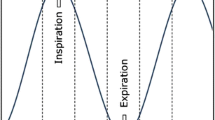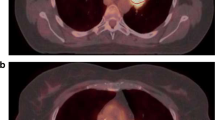Abstract
Purpose
The aim of this study was to compare planning target volume (PTV) defined on respiratory-gated positron emission tomography (PET)/CT (RG-PET/CT) to PTV based on ungated free-breathing CT and to evaluate if RG-PET/CT can be useful to personalize PTV by tailoring the target volume to the lesion motion in lung cancer patients.
Methods
Thirteen lung cancer patients (six men, mean age 70.0 years, 1 small cell lung cancer, 12 non-small cell lung cancer) who were candidates for radiation therapy were prospectively enrolled and submitted to RG-PET/CT. Ungated free-breathing CT images obtained during a PET/CT study were visually contoured by the radiation oncologist to define standard clinical target volumes (CTV1). Standard PTV (PTV1) resulted from CTV1 with the addition of 1-cm expansion of margins in all directions. RG-PET/CT images were contoured by the nuclear medicine physician and radiation oncologist according to a standardized institutional protocol for contouring gated images. Each CT and PET image of the patient’s respiratory cycle phases was contoured to obtain the RG-CT-based CTV (CTV2) and the RG-PET/CT-based CTV (CTV3), respectively. RG-CT-based and RG-PET/CT-based PTV (PTV2 and PTV3, respectively) were then derived from gated CTVs with a margin expansion of 7–8 mm in head to feet direction and 5 mm in anterior to posterior and left to right direction. The portions of gated PTV2 and PTV3 geometrically not encompassed in PTV1 (PTV2 out PTV1 and PTV3 out PTV1) were also calculated.
Results
Mean ± SD CTV1, CTV2 and CTV3 were 30.5 ± 33.2, 43.1 ± 43.2 and 44.8 ± 45.2 ml, respectively. CTV1 was significantly smaller than CTV2 and CTV3 (p = 0.017 and 0.009 with Student’s t test, respectively). No significant difference was found between CTV2 and CTV3. Mean ± SD of PTV1, PTV2 and PTV3 were 118.7 ± 94.1, 93.8 ± 80.2 and 97.0 ± 83.9 ml, respectively. PTV1 was significantly larger than PTV2 and PTV3 (p = 0.038 and 0.043 with Student’s t test, respectively). No significant difference was found between PTV2 and PTV3. Mean ± SD values of PTV2 out PTV1 and PTV3 out PTV1 were 12.8 ± 25.4 and 14.3 ± 25.9 ml, respectively. The percentage values of PTV2 out PTV1 and PTV3 out PTV1 were not lower than 10 % of PTV1 in 6/13 cases (46.2 %) and than 20 % in 3/13 cases (23.1 %).
Conclusion
Our preliminary data showed that RG-PET/CT in lung cancer can affect not only the volume of PTV but also its shape, as demonstrated by the assessment of gated PTVs outside standard PTV. The use of a gating technique is thus crucial for better delineating PTV by tailoring the target volume to the lesion motion in lung cancer patients.


Similar content being viewed by others
References
Nestle U, Walter K, Schmidt S, Licht N, Nieder C, Motaref B, et al. 18F-deoxyglucose positron emission tomography (FDG-PET) for the planning of radiotherapy in lung cancer: high impact in patients with atelectasis. Int J Radiat Oncol Biol Phys 1999;44(3):593–7.
Mah K, Caldwell CB, Ung YC, Danjoux CE, Balogh JM, Ganguli SN, et al. The impact of (18)FDG-PET on target and critical organs in CT-based treatment planning of patients with poorly defined non-small-cell lung carcinoma: a prospective study. Int J Radiat Oncol Biol Phys 2002;52(2):339–50.
Bradley J, Thorstad WL, Mutic S, Miller TR, Dehdashti F, Siegel BA, et al. Impact of FDG-PET on radiation therapy volume delineation in non-small-cell lung cancer. Int J Radiat Oncol Biol Phys 2004;59(1):78–86. doi:10.1016/j.ijrobp.2003.10.044.
MacManus M, Nestle U, Rosenzweig KE, Carrio I, Messa C, Belohlavek O, et al. Use of PET and PET/CT for radiation therapy planning: IAEA expert report 2006–2007. Radiother Oncol 2009;91(1):85–94. doi:10.1016/j.radonc.2008.11.008.
Nehmeh SA, Erdi YE, Ling CC, Rosenzweig KE, Schoder H, Larson SM, et al. Effect of respiratory gating on quantifying PET images of lung cancer. J Nucl Med 2002;43(7):876–81.
Nehmeh SA, Erdi YE, Ling CC, Rosenzweig KE, Squire OD, Braban LE, et al. Effect of respiratory gating on reducing lung motion artifacts in PET imaging of lung cancer. Med Phys 2002;29(3):366–71.
Erdi YE, Nehmeh SA, Pan T, Pevsner A, Rosenzweig KE, Mageras G, et al. The CT motion quantitation of lung lesions and its impact on PET-measured SUVs. J Nucl Med 2004;45(8):1287–92.
Osman MM, Cohade C, Nakamoto Y, Wahl RL. Respiratory motion artifacts on PET emission images obtained using CT attenuation correction on PET-CT. Eur J Nucl Med Mol Imaging 2003;30(4):603–6. doi:10.1007/s00259-002-1024-x.
Pan T, Mawlawi O, Nehmeh SA, Erdi YE, Luo D, Liu HH, et al. Attenuation correction of PET images with respiration-averaged CT images in PET/CT. J Nucl Med 2005;46(9):1481–7.
Mawlawi O, Pan T, Macapinlac HA. PET/CT imaging techniques, considerations, and artifacts. J Thorac Imaging 2006;21(2):99–110.
Bowen SR, Nyflot MJ, Gensheimer M, Hendrickson KR, Kinahan PE, Sandison GA, et al. Challenges and opportunities in patient-specific, motion-managed and PET/CT-guided radiation therapy of lung cancer: review and perspective. Clin Transl Med 2012;1(1):18. doi:10.1186/2001-1326-1-18.
Keall PJ, Mageras GS, Balter JM, Emery RS, Forster KM, Jiang SB, et al. The management of respiratory motion in radiation oncology report of AAPM Task Group 76. Med Phys 2006;33(10):3874–900.
Colgan R, McClelland J, McQuaid D, Evans PM, Hawkes D, Brock J, et al. Planning lung radiotherapy using 4D CT data and a motion model. Phys Med Biol 2008;53(20):5815–30. doi:10.1088/0031-9155/53/20/017.
Guckenberger M, Wilbert J, Krieger T, Richter A, Baier K, Flentje M. Mid-ventilation concept for mobile pulmonary tumors: internal tumor trajectory versus selective reconstruction of four-dimensional computed tomography frames based on external breathing motion. Int J Radiat Oncol Biol Phys 2009;74(2):602–9. doi:10.1016/j.ijrobp.2008.12.062.
Hof H, Rhein B, Haering P, Kopp-Schneider A, Debus J, Herfarth K. 4D-CT-based target volume definition in stereotactic radiotherapy of lung tumours: comparison with a conventional technique using individual margins. Radiother Oncol 2009;93(3):419–23. doi:10.1016/j.radonc.2009.08.040.
Underberg RW, Lagerwaard FJ, Slotman BJ, Cuijpers JP, Senan S. Benefit of respiration-gated stereotactic radiotherapy for stage I lung cancer: an analysis of 4DCT datasets. Int J Radiat Oncol Biol Phys 2005;62(2):554–60. doi:10.1016/j.ijrobp.2005.01.032.
Wolthaus JW, Schneider C, Sonke JJ, van Herk M, Belderbos JS, Rossi MM, et al. Mid-ventilation CT scan construction from four-dimensional respiration-correlated CT scans for radiotherapy planning of lung cancer patients. Int J Radiat Oncol Biol Phys 2006;65(5):1560–71. doi:10.1016/j.ijrobp.2006.04.031.
Wolthaus JW, Sonke JJ, van Herk M, Belderbos JS, Rossi MM, Lebesque JV, et al. Comparison of different strategies to use four-dimensional computed tomography in treatment planning for lung cancer patients. Int J Radiat Oncol Biol Phys 2008;70(4):1229–38. doi:10.1016/j.ijrobp.2007.11.042.
Wolthaus JW, Sonke JJ, van Herk M, Damen EM. Reconstruction of a time-averaged midposition CT scan for radiotherapy planning of lung cancer patients using deformable registration. Med Phys 2008;35(9):3998–4011.
De Ruysscher D, Faivre-Finn C, Nestle U, Hurkmans CW, Le Péchoux C, Price A, et al. European Organisation for Research and Treatment of Cancer recommendations for planning and delivery of high-dose, high-precision radiotherapy for lung cancer. J Clin Oncol 2010;28(36):5301–10. doi:10.1200/JCO.2010.30.3271.
Liu HH, Balter P, Tutt T, Choi B, Zhang J, Wang C, et al. Assessing respiration-induced tumor motion and internal target volume using four-dimensional computed tomography for radiotherapy of lung cancer. Int J Radiat Oncol Biol Phys 2007;68(2):531–40. doi:10.1016/j.ijrobp.2006.12.066.
Underberg RW, Lagerwaard FJ, Slotman BJ, Cuijpers JP, Senan S. Use of maximum intensity projections (MIP) for target volume generation in 4DCT scans for lung cancer. Int J Radiat Oncol Biol Phys 2005;63(1):253–60. doi:10.1016/j.ijrobp.2005.05.045.
Korreman S, Persson G, Nygaard D, Brink C, Juhler-Nøttrup T. Respiration-correlated image guidance is the most important radiotherapy motion management strategy for most lung cancer patients. Int J Radiat Oncol Biol Phys 2012;83(4):1338–43. doi:10.1016/j.ijrobp.2011.09.010.
Paumier A, Crespeau A, Krhili S, Georgin-Mège M, Tuchais C, Mesgouez J, et al. Dosimetric study of the different techniques to deal with respiratory motion for lung stereotactic radiotherapy. Cancer Radiother 2012;16(4):263–71. doi:10.1016/j.canrad.2012.03.004.
Rietzel E, Liu AK, Doppke KP, Wolfgang JA, Chen AB, Chen GT, et al. Design of 4D treatment planning target volumes. Int J Radiat Oncol Biol Phys 2006;66(1):287–95. doi:10.1016/j.ijrobp.2006.05.024.
Lupi A, Zaroccolo M, Salgarello M, Malfatti V, Zanco P. The effect of 18F-FDG-PET/CT respiratory gating on detected metabolic activity in lung lesions. Ann Nucl Med 2009;23(2):191–6. doi:10.1007/s12149-008-0225-1.
García Vicente AM, Soriano Castrejón AM, Talavera Rubio MP, León Martín AA, Palomar Muñoz AM, Pilkington Woll JP, et al. 18F-FDG PET-CT respiratory gating in characterization of pulmonary lesions: approximation towards clinical indications. Ann Nucl Med 2010;24(3):207–14. doi:10.1007/s12149-010-0345-2.
Guerra L, De Ponti E, Elisei F, Bettinardi V, Landoni C, Picchio M, et al. Respiratory gated PET/CT in a European multicentre retrospective study: added diagnostic value in detection and characterization of lung lesions. Eur J Nucl Med Mol Imaging 2012;39(9):1381–90. doi:10.1007/s00259-012-2148-2.
Aristophanous M, Berbeco RI, Killoran JH, Yap JT, Sher DJ, Allen AM, et al. Clinical utility of 4D FDG-PET/CT scans in radiation treatment planning. Int J Radiat Oncol Biol Phys 2012;82(1):e99–e105. doi:10.1016/j.ijrobp.2010.12.060.
Boellaard R, O’Doherty MJ, Weber WA, Mottaghy FM, Lonsdale MN, Stroobants SG, et al. FDG PET and PET/CT: EANM procedure guidelines for tumour PET imaging: version 1.0. Eur J Nucl Med Mol Imaging 2010;37(1):181–200.
Erdi YE, Mawlawi O, Larson SM, Imbriaco M, Yeung H, Finn R, et al. Segmentation of lung lesion volume by adaptive positron emission tomography image thresholding. Cancer 1997;80(12 Suppl):2505–9.
Ekberg L, Holmberg O, Wittgren L, Bjelkengren G, Landberg T. What margins should be added to the clinical target volume in radiotherapy treatment planning for lung cancer? Radiother Oncol 1998;48(1):71–7.
Seppenwoolde Y, Shirato H, Kitamura K, Shimizu S, van Herk M, Lebesque JV, et al. Precise and real-time measurement of 3D tumor motion in lung due to breathing and heartbeat, measured during radiotherapy. Int J Radiat Oncol Biol Phys 2002;53(4):822–34.
Sonke JJ, Lebesque J, van Herk M. Variability of four-dimensional computed tomography patient models. Int J Radiat Oncol Biol Phys 2008;70(2):590–8. doi:10.1016/j.ijrobp.2007.08.067.
ICRU. International Commission on Radiation Units and Measurements. Prescribing, recording and reporting photon beam therapy. In: ICRU Report 62. J. ICRU. Oxford: Oxford University Press
Lee JA. Segmentation of positron emission tomography images: some recommendations for target delineation in radiation oncology. Radiother Oncol 2010;96(3):302–7. doi:10.1016/j.radonc.2010.07.003.
Bayne M, Hicks RJ, Everitt S, Fimmell N, Ball D, Reynolds J, et al. Reproducibility of “intelligent” contouring of gross tumor volume in non-small-cell lung cancer on PET/CT images using a standardized visual method. Int J Radiat Oncol Biol Phys 2010;77(4):1151–7. doi:10.1016/j.ijrobp.2009.06.032.
Conflicts of interest
None.
Author information
Authors and Affiliations
Corresponding author
Rights and permissions
About this article
Cite this article
Guerra, L., Meregalli, S., Zorz, A. et al. Comparative evaluation of CT-based and respiratory-gated PET/CT-based planning target volume (PTV) in the definition of radiation treatment planning in lung cancer: preliminary results. Eur J Nucl Med Mol Imaging 41, 702–710 (2014). https://doi.org/10.1007/s00259-013-2594-5
Received:
Accepted:
Published:
Issue Date:
DOI: https://doi.org/10.1007/s00259-013-2594-5




